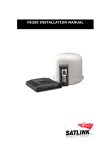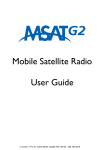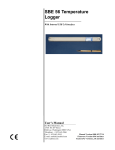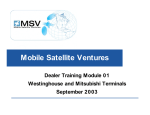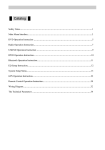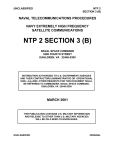Download MSV MSAT G2 Specifications
Transcript
Introduction . . . . . . . . . . . . . . . . . . . . . . . . . . . . . . . . . . . . . . . . . . . . . . . . . . . . . . . . . . . . . . . . . . . . Transceiver Unit (TU) . . . . . . . . . . . . . . . . . . . . . . . . . . . . . . . . . . . . . . . . . . . . . . . . . . . . . . . . . . . Power Port . . . . . . . . . . . . . . . . . . . . . . . . . . . . . . . . . . . . . . . . . . . . . . . . . . . . . . . . . . . . . . . . . . Ethernet and Serial Ports . . . . . . . . . . . . . . . . . . . . . . . . . . . . . . . . . . . . . . . . . . . . . . . . . . . . . . RJ 45 Ethernet Port . . . . . . . . . . . . . . . . . . . . . . . . . . . . . . . . . . . . . . . . . . . . . . . . . . . . . . . . . . . Serial Port . . . . . . . . . . . . . . . . . . . . . . . . . . . . . . . . . . . . . . . . . . . . . . . . . . . . . . . . . . . . . . . . . . . Antenna Port . . . . . . . . . . . . . . . . . . . . . . . . . . . . . . . . . . . . . . . . . . . . . . . . . . . . . . . . . . . . . . . . . Handset Port . . . . . . . . . . . . . . . . . . . . . . . . . . . . . . . . . . . . . . . . . . . . . . . . . . . . . . . . . . . . . . . . . External Speaker . . . . . . . . . . . . . . . . . . . . . . . . . . . . . . . . . . . . . . . . . . . . . . . . . . . . . . . . . . . . . . System Power Requirements . . . . . . . . . . . . . . . . . . . . . . . . . . . . . . . . . . . . . . . . . . . . . . . . . . . . . Standard Cable Connections . . . . . . . . . . . . . . . . . . . . . . . . . . . . . . . . . . . . . . . . . . . . . . . . . . . . . Horn Alert (Blue Wire - Optional Installation) . . . . . . . . . . . . . . . . . . . . . . . . . . . . . . . . . . . . Ignition Sense (Orange Wire) . . . . . . . . . . . . . . . . . . . . . . . . . . . . . . . . . . . . . . . . . . . . . . . . . . . . Basic Installation Procedure . . . . . . . . . . . . . . . . . . . . . . . . . . . . . . . . . . . . . . . . . . . . . . . . . . . . . . Fixed-site Installation . . . . . . . . . . . . . . . . . . . . . . . . . . . . . . . . . . . . . . . . . . . . . . . . . . . . . . . . . . . . Choosing a Location . . . . . . . . . . . . . . . . . . . . . . . . . . . . . . . . . . . . . . . . . . . . . . . . . . . . . . . . . . Lightning Arrestors . . . . . . . . . . . . . . . . . . . . . . . . . . . . . . . . . . . . . . . . . . . . . . . . . . . . . . . . . . . Installing the TU – Fixed-site and Vehicle . . . . . . . . . . . . . . . . . . . . . . . . . . . . . . . . . . . . . . . . . . Installation – General . . . . . . . . . . . . . . . . . . . . . . . . . . . . . . . . . . . . . . . . . . . . . . . . . . . . . . . . . Mounting Bracket Information . . . . . . . . . . . . . . . . . . . . . . . . . . . . . . . . . . . . . . . . . . . . . . . . The Antenna Unit (AU) . . . . . . . . . . . . . . . . . . . . . . . . . . . . . . . . . . . . . . . . . . . . . . . . . . . . . . . . . . Antenna Cable Lengths and Types . . . . . . . . . . . . . . . . . . . . . . . . . . . . . . . . . . . . . . . . . . . . . Installing the Antenna . . . . . . . . . . . . . . . . . . . . . . . . . . . . . . . . . . . . . . . . . . . . . . . . . . . . . . . . . SpaceCom SPAC-AS-MSV220 Land-Mobile / Fixed-site Antenna . . . . . . . . . . . . . . . . . . . . Magnetic (Temporary) Mounting option . . . . . . . . . . . . . . . . . . . . . . . . . . . . . . . . . . . . . . . . Permanent (Mast) Mounting . . . . . . . . . . . . . . . . . . . . . . . . . . . . . . . . . . . . . . . . . . . . . . . . . . . SPAC-AS-MSV320 Maritime Antenna . . . . . . . . . . . . . . . . . . . . . . . . . . . . . . . . . . . . . . . . . . . . . Pole Mount Kit . . . . . . . . . . . . . . . . . . . . . . . . . . . . . . . . . . . . . . . . . . . . . . . . . . . . . . . . . . . . . . . Pole Mount Kit Component Description . . . . . . . . . . . . . . . . . . . . . . . . . . . . . . . . . . . . . . . SPAC-AS-MSV320 Antenna Installation . . . . . . . . . . . . . . . . . . . . . . . . . . . . . . . . . . . . . . . . . Vibration . . . . . . . . . . . . . . . . . . . . . . . . . . . . . . . . . . . . . . . . . . . . . . . . . . . . . . . . . . . . . . . . . . . . . Installing the Handset . . . . . . . . . . . . . . . . . . . . . . . . . . . . . . . . . . . . . . . . . . . . . . . . . . . . . . . . . . . Commissioning Procedure . . . . . . . . . . . . . . . . . . . . . . . . . . . . . . . . . . . . . . . . . . . . . . . . . . . . . . . Troubleshooting the Installation . . . . . . . . . . . . . . . . . . . . . . . . . . . . . . . . . . . . . . . . . . . . . . . . . . Steps to Basic Troubleshooting . . . . . . . . . . . . . . . . . . . . . . . . . . . . . . . . . . . . . . . . . . . . . . . . Troubleshooting Some Typically Encountered Problems: . . . . . . . . . . . . . . . . . . . . . . . . . MSAT-G2 Technical Specifications . . . . . . . . . . . . . . . . . . . . . . . . . . . . . . . . . . . . . . . . . . . . . . . . . MSAT-G2 Installation Guide 1 3 4 4 4 5 5 6 6 7 9 9 9 10 10 10 11 11 11 11 14 14 14 15 16 17 18 18 19 21 21 23 23 26 26 27 28 Introduction The purpose of this guide is to provide assistance to personnel installing the new MSAT-G2 mobile satellite radio equipment. The guide starts off by providing installation-specific information on each component of the radio. Installation tips are then offered for fixed-site and vehicular scenarios. A section on commissioning instructions follows. The guide concludes with a troubleshooting section. Installation Warning This product is to be installed by Authorized Service Personnel. Damages resulting in the failure to conform to the instructions found herein, as well as standard installation practices, will be the responsibility of the installer. MSAT-G2 Mobile Satellite Radio The MSAT-G2 mobile satellite radio is comprised of three core component parts: the transceiver unit (the small black box), the antenna system (white domes) and the handset. Figure 1 – MSAT-G2 Mobile Satellite Radio Components MSAT-G2 Installation Guide 1 An optional external speaker may be connected to the TU for remote monitoring. Serial and ethernet ports are provided for external interfacing, debugging, software upgrading and future expansion capabilities. Antenna Unit Antenna Cable External Interface Serial PC Debug/Upgrade/ Future Expansion External Speaker External Speaker Transceiver Unit Ethernet Handset Cable Power Cable Handset 12 power supply Figure 2 – System Overview MSAT-G2 Installation Guide 2 Transceiver Unit (TU) The TU provides the interface for the handset and antenna unit (AU) and manages the communications over the MSV network. It also distributes power to the handset and Antenna Unit (AU). FRONT BACK Figure 3 - Transceiver Unit w/o Mounting Bracket MSAT-G2 Installation Guide 3 The TU is equipped with the following ports: Power Port The power port is the connection from the power supply (vehicle battery or some other 12 VDC power source) to the TU. The power cable has a +12V power line, a +12V ignition sense line, a horn alert line and a ground line. HORN ALERT AWG 20, STRANDED, BLUE GND AWG 16, STRANDED, BLACK 0.25 A, 1-1/4 BY 1/4 FUSE 5 A, 1 1/4 BY 1/4 FUSE IGNITION SENSE AWG 20, STRANDED, ORANGE VIEW A Line Type +12VDC Ground Ignition Sense Horn Alert 12 V AWG 16, STRANDED, RED Colour Red Black Orange Blue Figure 4 – Power Port Cable Colour Reference Ethernet and Serial Ports RJ 45 Ethernet Port The RJ 45 Ethernet port is available for upgrade and future expansion of functionality. The port supplies standard Ethernet line levels and supports all defined control line signaling. The pinout of the port supports a direct straight-through connection to a PC with a standard Ethernet cable. The PC shall be supplied with a dynamic local IP address using a standard DHCP exchange. Pin 1 2 3 6 RX+ RXTX+ TX- Figure 5 – Ethernet Port Pinout MSAT-G2 Installation Guide 4 Serial Port The serial port is a female DB-9F RS 232 and can be used for NMEA output (GPS) and crossbanding. Pin Data (currently not supported) 1 2 3 4 5 6 7 8 9 CD (Carrier Detect) RD (Receive Data) TD (Transmit Data) DTR (Data Terminal Ready) GND (Signal Ground) DSR (Data Set Ready) RTS( Request To Send) CTS (Clear To Send) RI (Ring Indicator) GPS Crossband COR (Carrier Operated Relay) RD (Receive Data) GND (Signal Ground) GND (Signal Ground) PTT (Push To Talk) CTT (Clear To Transmit) Figure 6 – Serial Port Pinout Antenna Port The antenna port is a 50 Ohm female TNC. This line carries RF, signaling, and DC power for the antenna. Note: Grounding the center conductor while power is applied to the transceiver can cause the transceiver's fuse and/or a fuse in the vehicle to blow. No modifications should be made to the RF cable under any circumstance Figure 7 – Antenna Port Detail MSAT-G2 Installation Guide 5 Handset Port The RJ45 handset port is used to connect the handset to the TU. The connector type is a modular 8 position and 8 conductor RJ45. The pinout is as follows Pin Number Signal Name 1 2 3 4 5 6 7 Audio TX + Microphone Audio TX – Microphone Data TX – TU Send Data RX – TU Receive + 12 VDC Ground Audio RX + Speaker 8 Audio RX - Speaker Figure 8: Handset Connector Pin-out External Speaker A 3.5 mm mono connection is provided for a 4W 8Ohm speaker. MSAT-G2 Installation Guide 6 Figure 9 – Transceiver Unit Front & Back System Power Requirements There is only one power connection for the entire radio. This must be connected to a 12 VDC power supply. Power requirements and consumption are as follows: Voltage Input Minimum 11.5 V DC Voltage Input Maximum 15.6 V DC Total Current for AU,TU & Handset (Max.) 3A Required Fuse 5A Figure 10 – System Power Requirements MSAT-G2 Installation Guide 7 Power Cable 10 + / - 0 . 5 INCHES VIEW A 6 + / - 0 . 5 INCHES 20 FEET + / - 4 INCHES HORN ALERT AWG 20, STRANDED, BLUE GND AWG 16, STRANDED, BLACK 0.25 A, 1-1/4 BY 1/4 FUSE 5 A, 1 1/4 BY 1/4 FUSE IGNITION SENSE AWG 20, STRANDED, ORANGE VIEW A 12 V AWG 16, STRANDED, RED HOUSING : MOLEX PART NO. 39-01-2045 TERMINAL: MOLEX PART NO. 44476-3111 (FOR AWG IG WIRE) AND 44476-1111 (FOR 20 WIRE) IN LINE FUSE HOLDER Figure 11 – Power Cable Details MSAT-G2 Installation Guide 8 Standard Cable Connections In addition to the DC power connection, optional horn alert and ignition sense connections may be made. These are all done using the four wire power cable. In the case of a vehicle installation, the power source is typically the vehicle battery. Cables should be routed appropriately and cable ties and clamps should be used as required to ensure that vibration and/or rubbing of the cables does not occur. Horn Alert (Blue Wire - Optional Installation) To install the Horn Alert, route and splice the blue wire (Horn Alert) as shown below. Note that the Horn Alert option is not available in Dispatch Radio mode. 12 VDC or ground as required by vehicle To auto horn +12 VDC Note: 0.25 amp fuse required To TU Horn Alert (GND) (BLUE Wire) Figure 12 – Horn Alert Wiring Diagram Ignition Sense (Orange Wire) Route and connect the orange wire (Ignition Sense) to a switched 12 VDC source, such as ignition switch or fuse block. Extended use of ignition sense in accessory position (ACC) by the end user may lead to a discharged car battery. NOTE: Ensure that the connection is a switched source-OFF when ignition is off or in start and ON only when ignition switch is in ACCESSORIES or RUN position. MSAT-G2 Installation Guide 9 Basic Installation Procedure While the installation of the MSAT-G2 mobile satellite radio is straightforward, it is essential that the installation be done correctly. The basic installation procedure is as follows: 1. Decide where you are going to install the antenna, TU and handset. 2. Ensure that the TU is located inside the vehicle or a building and that it is attached to something structurally sound. Loose mounts that vibrate will degrade performance. 3. Determine the cabling required for the installation of each component. 4. Perform the installation of the antenna, TU and handset. 5. Connect the antenna and the handset to the TU 6. Connect the power to the TU. 7. Power up and commission the radio Fixed-site Installation Choosing a Location It is important to choose a location for the antenna that will have a clear line-of-site to the satellite(s). Preferably, avoid all obstructions within three (3) meters of the antenna. Installation during windy conditions may be dangerous. The owner and installer assume all responsibility to ensure that the equipment is properly installed with adequate structural stability of mounting surface to withstand all loads (wind, weight, ice, etc.) and is properly sealed to avoid leaks. DO NOT ATTEMPT TO INSTALL OR DISMANTLE THE EQUIPMENT NEAR ANY TYPE OF POWER LINE. Safety Rules: 1) Select your installation site with safety as well as performance in mind. 2) Plan your installation carefully before beginning. Perform as many tasks as possible while on the ground. 3) If any part of the equipment (i.e. antenna assembly) comes into contact with a power line, do not try to remove it yourself. Contact your local power company. 4) When installing an antenna assembly, do not use a metal ladder. 5) If the antenna assembly starts to drop, get away from it and let it fall. 6) Verify that the antenna is properly grounded. MSAT-G2 Installation Guide 10 Lightning Arrestors The applicable electrical code(s) may require that lightning arrestors capable of supporting Lband transmissions be installed on all cabling between the fixed-site antenna and the structure which the equipment is housed in. It is also suggested that any structure containing the radio be equipped with a lightning rod connected to the ground. The professional doing the fixedsite installation is responsible for determining all such requirements with the customer and installing the equipment such that it complies with all applicable standards. Installing the TU – Fixed-site and Vehicle Installation – General 1) For ease of service, route the radio cables and power cables together. 2) Always disconnect the negative side of the vehicle battery prior to any electrical work. 3) Whenever routing cable through holes drilled in metal or through bulkheads, use grommets and RTV sealant to weatherproof all holes drilled on the outside of the vehicle. 4) Use cable ties every 30 – 45 cm (12-18”). 5) The TU can be mounted in either the horizontal or vertical position. 6) The main power line should be connected directly to the vehicle battery (or 12 VDC power supply). If you must connect it to another circuit, ensure sufficient amperage is available. In the case of a fixed-site installation, tie the Battery and Ignition Sense wires together on the 12 VDC power source. 7) The ground line should be connected directly to the vehicle’s battery ground. 8) Install the TU in a protected but ventilated area (inside building or vehicle). Allow at least a one (1) inch space around all surfaces, except for the surface attached to the mounting bracket to provide adequate cooling. Ensure that the location is accessible for servicing. 9) The TU is not waterproof. 10) Always provision the wiring into the TU with a drip loop. 11) With the exception of the TU to Antenna cable, do not route the cables outside the vehicle. Mounting Bracket Information NOTE: Use care when drilling through the body of the vehicle to avoid puncturing critical items. The bracket is connected to the TU with two (2) provided screws. There is a 5mm gap between the TU and the bracket. MSAT-G2 Installation Guide 11 Instructions for the installer: 1. The mounting bracket should be used for mounting the TU. 2. Mount the mounting bracket onto a flat surface using at least four (4) screws (not supplied). Use screws with diameter between 3 to 4.5 mm. Vibration resistant screws or lock washers should be used. 3. Choose any suitable holes and slots on the base of the mounting bracket for mounting the screws. If space is available on the mounting surface, the screws should be spaced as far as possible towards the corners of the mounting bracket to provide good stability. 4. Place the TU on the mounting bracket so that the holes on the side flanges of the mounting bracket are aligned with the threaded inserts on the TU. Use only the two screws and spring washers provided to secure the TU to the mounting bracket. Not using the supplied bracket screws could result in damage to the TU (especially if screws are too long). MOUNTING HOLE DIMENSIONS BOUNTING BRACKET, MSV Dimensions are in mm Figure 13 - Transceiver Unit Mounting Bracket Dimensions MSAT-G2 Installation Guide 12 DIMENSIONS WITH MOUNTING BRACKET MSV TRANSCEIVER UNIT ETH I SER HA ND AL PO ERN ET RT SET 176.83 33.6 HANDSET SERIAL PORT ETHERNET 5 Dimensions are in mm Figure 14 - Transceiver Unit w/ Mounting Bracket MSAT-G2 Installation Guide 13 The Antenna Unit (AU) The antenna unit is composed of the antenna element array, necessary high power and low noise amplifier systems and a tracking system. Two AU versions exist: a 2-axis unit intended for land-mobile and fixed-site installations and a 3-axis unit for the maritime environment. Connection to both AUs is made by a TNC connector. The single co-axial cable carries RX, TX, power and tracking information. Antenna Cable Lengths and Types The radio has been type approved for use with the following cable lengths and types: Cable Length Antenna to Radio 20 ft 60 ft 150 ft Cable Type RG223/U LMR240 (Equiv.) LMR600 (Equiv.) Figure 15 – Antenna Cable Lengths and Types Installing the Antenna WARNING: Avoid exposure to microwave radiation. Keep a safe distance of minimum one 1 meter (39 inches) to the side and above the antenna. Always power the MSAT-G2 down prior to disconnecting or connecting the antenna. The antenna port is a 50 Ohm female TNC. This line carries RF, signaling, and DC power for the antenna. Note: Grounding the center conductor while power is applied to the transceiver can cause the transceiver's fuse and/or a fuse in the vehicle to blow. No modifications should be made to the RF cable under any circumstance. Keep a clear line-of-sight to the satellite. Preferably, avoid all obstructions within three (3) meters of the antenna. Obstructions less than 15 cm (6 inches) in diameter can be ignored beyond this distance. If the antenna is being mounted on a vehicle it is important to ensure there is a clear line-ofsite to the satellite(s) in all directions. After the radio is commissioned and operational it is recommended that the signal strength be checked while the vehicle is slowly driven in a 360º circle. The signal strength should not vary significantly or be degraded in any particular direction. MSAT-G2 Installation Guide 14 Do not locate the antenna close to interfering signal sources or receivers. It is recommended that no other antennas be located within three (3) meters of the MSAT-G2 antenna. If there is other equipment installed near the MSAT-G2 satellite radio it is recommended to operate all equipment simultaneously and verify there is no co-interference. SpaceCom SPAC-AS-MSV220 Land-Mobile / Fixed-site Antenna Magnetic (Temporary) Mounting option For temporary use – or where drilling of holes is to be avoided – a Magnetic Mount Installation Kit is offered. SpaceCom part no: SPAC-AC-1016. Three (3) magnetic mounts each with an adhesive force of at least 420 N (Newton) are required to secure the MSV220 antenna. Figure 16 – SPAC-AS-MSV220 2-axis Antenna W/ Magnetic Mounts MSAT-G2 Installation Guide 15 Magnetic Mount Installation The Magnet Mount consists of (3) three individual high intensity magnets with rubber coating. Each magnet has a stainless steel M5 center bolt. First attach the magnets to the antenna. There are (3) three “legs” on the antenna where the magnets are placed. Note the position of the two nylon (plastic) washers just below and above each “leg”, the stainless steel washer above the upper nylon washer and the M5 protective nut on top. Now place the antenna with magnets on the roof of the car. When installing the antenna cable, it’s important to protect against moisture – using self amalgating tape, or similar, wrapped around the coaxial connector. Also be careful with the cable run from the antenna and secure it at short intervals. An unsupported length of cable will vibrate when driving and could negatively affect the connection over time. Dismounting: Grab the antenna near one of the magnets and lift. When one magnet is loose, the other two are easy to “break off”. In some situations the force of the magnet may be too great and it will be necessary to unscrew the antenna first and remove the magnets separately. Hex domed nut M5 washer Rubber washer Rubber washer High “intensity” magnet Figure 17 – SPAC-AS-MSV220 2-axis Antenna W/ Magnetic Mounts MSAT-G2 Installation Guide 16 Permanent (Mast) Mounting For permanent mounting of the SPAC-AS-MSV220, a special Pole Mount Installation Kit is available. SpaceCom part no.: SPAC-AC-1017. Designed for easy installation, it ensures proper drainage of the antenna, galvanic insulation and is able to withstand the rigid mechanical stress. Figure 18 – SPAC-AS-MSV220 2-axis Antenna W/ Optional Pole Mount SPAC-AS-MSV220 Antenna Pole Mount Installation The Pole Mount is made of stainless steel. The antenna is placed on the triangular top and the pole fixed using the U-clamps. (To a short mast or similar) First mount the antenna on top of the pole with (3) three pcs. M6x50 mm bolts. The (6) six pcs. nylon washers are used just below and above the antenna “legs” The 44 mm U-clamps are placed around the pole mount, leaving the 50 mm U-clamps for the mast. Small tolerances in the mast diameter can be compensated by simply bending the U-clamps slightly. When installing the antenna cable, it is important to protect against moisture – using self amalgating tape, or similar, wrapped around the coaxial connector. Also be careful with the cable run from the antenna and secure it at short intervals. An unsupported length of cable will vibrate in strong winds and could negatively affect the connection over time. MSAT-G2 Installation Guide 17 M6X50 screw M6 washer Rubber washer Rubber washer U-clamp ø44 mm M8 washer M8 self-locking nut M6 self-locking nut Clamp bracket U-clamp ø50mm Figure 19 – SPAC-AS-MSV220 2-axis Antenna W/ Optional Pole Mount SPAC-AS-MSV320 Maritime Antenna When installing a SpaceCom Maritime Antenna on a vessel the following important guidelines must be followed in order to ensure that the antenna will operate trouble-free throughout its service life. The warranty will be void if the guidelines are not followed. Pole Mount Kit The installation is based on a pole mounting kit AC-1005 and is shown in FIG. 21. The kit consist of the following components: (subject to change) 1pcs. Mounting Pole, Part No. SPAC-M00424 1pcs. Rubber Gasket, Part No. SPAC-M00425 6pcs. Plastic Bushings, Part No. SPAC-M00227 6pcs. Washer, Part No. SPAC-M90-10062 6pcs. Screw, Part No. SPAC-M90-10102 MSAT-G2 Installation Guide 18 2pcs. Clamp, Part No. SPAC-M00428 2pcs. Clamp, Part No. SPAC-M00429 8pcs. Nuts M8, Part No. SPAC-M90-10105 2pcs. Flange, Part No. SPAC-M00430 1pcs. Plug for Mounting Pole, Part No. SPAC-M00233 1pcs. Screw M5*10, Part No. SPAC-M90-10104 These components are shipped in one separate box. The installer, upon receipt of a box, is required to check the contents. Figure 20 – SPAC-AS-MSV320 Maritime Antenna W/ Optional Pole Mount Pole Mount Kit Component Description Mounting Pole Part No. SPAC-M00424 is a piece of standard tubing with a mounting flange welded onto it. The component is made from a stainless steel alloy that is easy to cut, machine and weld. It is part of the ventilating system for the dome. The standard length is 400mm and must not be shortened in maritime applications. Shorter versions for non-maritime applications may be supplied on special request. Rubber Gasket, Part No. SPAC-M00425 is used to ensure that water or dust does not enter into the area around the centre hole in the bottom of the dome. The centre hole is part of the ventilating system for the dome and MUST NOT BE BLOCKED. The gasket will also protect the TNC-type connector from water and dust. MSAT-G2 Installation Guide 19 Bushings, Part No. SPAC-M00227 are used to ensure NO electrical contact between the mechanical parts of the antenna (in the dome) and the mounting pole. This isolation is not required in vehicle installations but is required in maritime installations, where the antenna and co-axial cable to the antenna must be isolated from ships structure in order to avoid any circulating DC current that could cause uncontrolled corrosion. Washers, Part No. SPAC-M90-10062 are used to protect the plastic bushings SPAC-M00227 when the screws SPAC-M90-10102 are tightened to the specified torque. The washers MUST be used. Screws, Part No. SPAC-M90-10102 are M6 (metric), 25mm long screws made from stainless steel (A4) are used for fastening the antenna to the flange on the mounting pole so that the installation will endure vibrations and heavy loads due to wind or surges from rough sea. DO NOT CHANGE THE LENGTH OF THE SCREWS. Clamps, Part No. SPAC-M00428 are used to fasten the flanges SPAC-M00430 to the mounting pole, refer to FIG.21. Clamps, Part No. SPAC-M00429 are used to fasten the mounting pole to any post with a diameter between 35 and 50 mm, refer to FIG.21. Nuts, Part No. SPAC-M90-10105 are M8 nuts used for the clamps, refer to FIG.21 Nuts are to be tightened to 5Nm. Flange, Part No. SPAC-M00430 are used for linking the clamp holding forces. Plug, Part No. SPAC-M00233 is used for partly closing the bottom of the Mounting Pole so that no surge of water will fill the tube or damage any part of the antenna. Any condensing water within the antenna and/or tube will drop out by the plug. The plug will also prevent the coaxial cable from vibrating in the tube. Screw, M5*10, Part No. SPAC-M90-10104 is used to secure the plug. The kit offers the following advantages: • • • • Flexible and easy installation. Provides ventilation of the antenna while ensuring compliance with its relevant IP class. Protects the co-axial cable going to the antenna and its N-type connector. Isolates the antenna from the structure on which it is installed, this is a must in maritime installations where no DC current is allowed to flow through any part of the ship. MSAT-G2 Installation Guide 20 SPAC-AS-MSV320 Antenna Installation Installation of the 3-axis antenna on the mast is done according to FIG 21. The diameter of the post shall preferably be between 35 and 50 mm using the standard clamp supplied in the kit. Note the TORQUES for bolts and nuts. A small loop should be made on the co-axial cable near the plug SPAC M00233 in order to be able to pull the cable about 15 cm up through the mounting pole, when the antenna is installed or removed. If a long (e.g. 3m) post is used on board a ship it is recommended that this is fastened to the ship using standard clamps rather than welding. This will enable the post to be laid down in case removal of the antenna is required. Vibration The antennas (2- and 3-axis versions) are designed to meet the following operating vibration levels in any of three perpendicular directions measured at the mounting base of the radome i.e. at the flange of the standard mounting pole described above: Random Vibration 1.05 Grms with the following spectral density 5-20 Hz………….0.02G2/Hz 20-150 Hz……….-3dB/octave And further, Single Frequency Vibration 5-10 Hz with amplitude 2.54 mm 10-15 Hz with amplitude 0.76mm 15-25 Hz with amplitude 0.40mm 25-33 Hz with amplitude 0.23mm Vibration levels in a typical installation are usually much less than the above mentioned values. It is, however, the responsibility of the installer to verify that the cited levels are not exceeded in any mode of operation of the vehicle/vessel. In case of abnormal vibration, typically at a resonance frequency, measures much be taken in order to displace the resonance frequency or to dampen the vibration amplitude. MSAT-G2 Installation Guide 21 Coax cable With TNC type Connector Rubber gasket Part No.: SPAC-M00425 (1 ONLY). Plastic bushing Part No.: SPAC-M00227 (6 ONLY). Washer Part No.: SPAC- M90-10062 (6 ONLY). Screw Part No.: SPAC-M90-10102 (6 ONLY). To be tightened to 4Nm in two rounds Mounting pole Part No.: SPAC- M00421 (1 ONLY). 42.5 400 Nut M8 (8 ONLY) To be tightened to 10-1Nm U-Clamp SPAC-M00429 (2ONLY). U-Clamp SPAC-M00428 (2 ONLY). Post on vessel Flange SPAC-M00430 (2 ONLY). Screw M5x10 (1 ONLY) Plug for mounting pole Part No.: SPAC- MO0233 (1 0NLY) 35-50MM Figure 21 – SPAC-AS-MSV320 3-axis Antenna Installation Details MSAT-G2 Installation Guide 22 Installing the Handset The handset can be mounted using a standard-sized microphone clip mount (included). Select a mounting position for the handset. The handset should be placed in a location which is easy for the user to see and reach (arm’s length) and which does not impede the user’s movements or vehicle operation. The handset is rated for 25 feet of cable. CAT5 or better is recommended. The handset comes equipped with 6 foot coiled type cable. Commissioning Procedure In order for the unit to operate on the MSAT Network, it must first be commissioned – authorized for use. This task is generally only performed by qualified service personnel. If the unit has never been commissioned, it will power up in dealer mode. You can also access this function even after the unit has been commissioned if you are authorized to do so. 1. Power up the radio and press the 5 key within 1 second of the appearance of the “SEARCHING” message on display. 2. You are prompted to enter the DEALER PASSWORD (authorized personnel will have this password). Type it in and press OK. 3. You are then prompted to select the antenna type: TRACKING (for mobile applications) or OTHER (for future applications). Use the arrow keys to scroll to the appropriate option and press SELECT. 4. You are then prompted for each of the Commission Parameters: Control Channel Frequency (CFC), Pilot Channel Frequency (PFC), and Security Access Code (SASK). In each case, you are asked to type in the parameter and then press STORE to go onto the next parameter. 5. After you enter the set of values, a CONTINUE? Prompt asks you if you want to proceed with commissioning. Press YES to continue or NO to cancel the commissioning process. If you choose to proceed, two screens are displayed in succession: • COMMISSIONING indicates the general commissioning process is underway • COM: PVT indicates the Performance Verification Test is underway. If the entire commissioning process is successful a COM: SUCCESS screen is displayed. Control then reverts to the initial Idle Mode screen. If commissioning is not successful, you will receive a failure message (Network indicates that commissioning has failed, refer to figure 22 – Error Code Diagnostics on the following pages). Contact your Service Provider for assistance. MSAT-G2 Installation Guide 23 Error Code Diagnostics The following error messages may be displayed on the handset. Error Condition Definition Action FAILED TO COMMISSION The radio has been shutdown by the network. Contact MSV Customer Support. COM: NO RESP RETRY? Signifies that the network did not respond to the commissioning procedure initiated by the user. Ensure that you have a clear view of the southern sky and select YES to re-initiate the commissioning procedure. Contact MSV Customer Support if the radio fails to commission after several attempts COM: FAILURE RETRY? The commissioning process failed. Select YES to re-initiate the commissioning procedure. Contact MSV Customer Support if the radio fails to commission after several attempts. INVALID SASK Signifies the user has entered an invalid SASK while in the process of initiating the commissioning procedure. Check that you correctly entered the SASK. If the problem persists, contact MSV Customer Support to obtain the proper SASK value. SEARCHING… If signal strength bars are seen, the radio is in the process of connecting to the MSAT network. If signal strength bars are not seen, the radio cannot receive a satellite signal. If the condition persists, check the radio has a clear view of the southern sky and that the antenna is connected and is functioning (e.g. can hear the servo motor in the antenna). WAIT… Signifies that the radio has not received a response to the PTT request from the MSAT network and is attempting several retries. Continue to press the PTT key. If the call is successful, USER ON will be displayed. In the event a call fails, a PTT FAIL message will appear requiring the user to release the PTT key and try again. PTT FAIL Signifies the radio failed to receive a response to the PTT request from the MSAT network. Release the PTT key and try again. If this message continues, contact MSV Customer Support. PRESSPT Signifies the PTT key was been pressed then released just before the radio received the confirmation from the network. Press and hold the PTT key in order to talk. MSAT-G2 Installation Guide 24 INVALID DN Signifies the user has entered a Directory Number (DN) that is not a member of the private mode talk group currently active on the radio. Ensure a valid DN is entered in tag position 00. NO TG No talk groups have been downloaded to the radio. If this condition persists, contact MSV Customer Support. BLOCKED Signifies that the radio's antenna signal to the satellite is blocked. Ensure that the antenna has a clear line-of-sight to the satellite. X-OVER FAILURE Signifies that the user has initiated a manual beam cross-over to a beam that is not accessible. Following the appearance of the failure message the user will be returned to the beam options list. Ensure that the appropriate adjacent satellite beam is chosen when initiating a manual beam cross-over. RF POWER FAILURE The radio detected a problem with its RF transmissions and disabled that transmitter. Power cycle the radio. If this condition persists, contact MSV Customer Support. ANTENNA FAILURE This indicates the radio has detected a fault in the antenna and shut it down. Power cycle the radio. If this problem persists, contact MSV Customer Support WARNING! OVERHEAT Signifies that the radio is overheating. This message will appear at 10 second intervals until the temperature is reduced. If the temperature continues to increase then the radio will shutdown. Move the radio to a cooler place. If the radio powers off, allow it to cool down before re-initiating the power-up sequence. INVALID PASSWORD Signifies the user has entered the wrong Dealer or SYSTEM Menu password. Enter the correct password. If the password is unknown, contact MSV Customer Support with the radio's ESN. Customer Support can provide a new SYSTEM password. WRONG LOCK CODE Signifies the user has entered the wrong Handset Lock code. If you cannot remember the lock code (default is 0000), enter the SYSTEM password (default 1234) when prompted to enter the code. Figure 22 – Error Codes MSAT-G2 Installation Guide 25 Troubleshooting the Installation Steps to Basic Troubleshooting When troubleshooting, always record as much information as possible at all times. Start by asking the person who encountered the problem to describe the problem, the events leading up to the problem and any troubleshooting work that may have been done already. This information will be valuable when discussing the problem with others and will help to debug similar problems in the future. 1) Characterize the problem. Equipment performance: Did the unit power up successfully? What is shown on the handset display? Were any error codes displayed? Are you able to establish communications with another user? What is the received communications quality like? What does the transmitted communications quality sound like to other users? Environmental conditions: Record information about the location and the line-of-sight to the satellite: Are there any blockages? What are/were the weather conditions when the problem is/was encountered? Is there any pattern as to when the problems occur (i.e. always when it rains, always at 9 a.m., in the summertime but not the wintertime etc.) How long has the problem existed? When did it first show up? Is it intermittent; or is it always present? 2) Eliminate operator error Is the user familiar with the operation of the equipment? Have they used it successfully in the past? What was happening prior to the problem? 3) Is the problem really with the equipment? 4) Check the installation What is the integrity of the installation? Are the cable connections secure? Are the cables damaged in any way? Is the antenna system damaged? Is the TU damaged? Has any electrical or construction work been done near the TU, antenna or handset? Is the power supply working properly? MSAT-G2 Installation Guide 26 5) Troubleshoot by component Does the problem sound TU-related, antenna-related, handset-related or external equipment-related? Swap out a suspect component into a known working system (i.e. if the TU is suspect, try it out with a known working antenna and handset). It is highly recommended that a complete working satellite radio (TU, Handset, and AU) be part of any troubleshooting kit. Troubleshooting Some Typically Encountered Problems: 1) MT will not power up. Start by checking that the power supply is working properly. Check the power level supplied by the cable going into the TU. Check that the power cable is securely connected to the TU. 2) Commissioning Fails Is there sufficiently high enough signal strength? Check the antenna for line-of-sight. Check that the correct SASK, PFC & CFC are entered. Check the TU ESN – is this the correct TU? Check that the account is active and that the unit is in ready to commission status. 3) Signal Strength low/intermittent/none Check the antenna cable connection both at the TU and antenna. Check that the cable is not damaged in any way (pinched, cut etc.). MSAT-G2 Installation Guide 27 MSAT-G2 Technical Specifications Weight HUGHES 2100 TU = 0.8 lbs DT-200 Handset = 0.6 lbs SPAC-AS-MSV220 Antenna = 4.6 lbs SPAC-AS-MSV320 Antenna = 10.3 lbs Dimensions HUGHES 2100 TU = (W) 6.5” x (H) 1.1” x (D) 5.6” DT-200 Handset = (W) 2.9” x (H) 1.4” x (D) 6.8” SPAC-AS-MSV220 Antenna = (Diameter) 9.8” x (Height) 3.9” SPAC-AS-MSV320 Antenna = (Diameter) 11” x (Height) 11” Power Input voltage: 11.5 to 15.6 VDC Input current: 3 Amps max. Fuses Power cable assembly 3004028-0001 Battery (red wire): 5 Amp / 250 Volt Horn Alert (blue wire): 0.25 Amp / 250 Volt CAUTION: For continued protection against risk of fire, replace only with same type and rating of fuse Humidity 98% at 100.4°F (38°C) Operating Temperature Antenna = -22°F(-30°C) to +109°F(+43°C) TU = -22°F(-30°C) to +131°F(+55°C) Dust In Accordance with SAE J1455 section 4.7 Rain Antenna = Precipitation rate of 2” /hour Figure 23 – Technical Specifications MSAT-G2 Installation Guide 28 Mobile Satellite Ventures Customer Service 1-800-216-6728 [email protected] Copyright © 2005 MSV All rights reserved. This publication and its contents are proprietary to Mobile Satellite Ventures, LP. No part of this publication may be reproduced in any form or by any means without the written permission of Mobile Satellite Ventures, LP, 10802 Parkridge Boulevard, Reston, VA 20191-4334 Mobile Satellite Ventures, LP, has made every effort to ensure the correctness and completeness of the material in this document. Mobile Satellite Ventures, LP, shall not be liable for errors contained herein. The information in this document is subject to change without notice. Mobile Satellite Ventures, LP, makes no warranty of any kind with regard to this material, including, but not limited to, the implied warranties of merchantability and fitness for a particular purpose. Trademarks All trademarks, marks, names, or product names referenced in this publication are the property of their respective owners, and Mobile Satellite Ventures, LP, neither endorses nor otherwise sponsors any such products or services referred to herein. MSV is a trademark of Mobile Satellite Ventures, LP. MSAT-G2 Installation Guide 29































